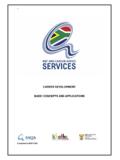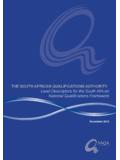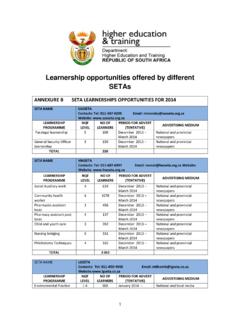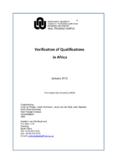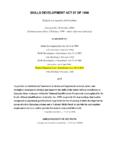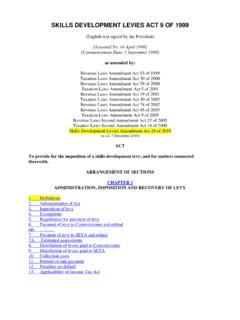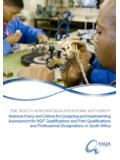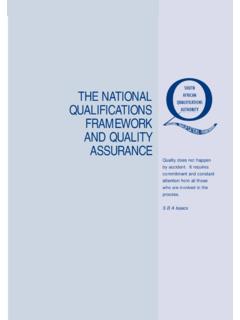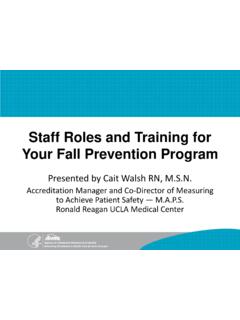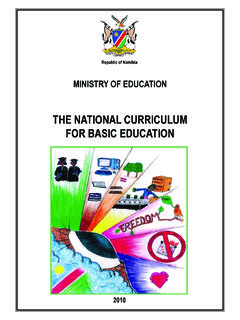Transcription of Quality Management Systems for Education and Training ...
1 Quality Management Systems for Education and Training Providers Please direct all queries to: The Executive Officer SAQA. Attention: Ronel Heyns Assistant Director Quality Assurance and Development RE: Quality Management Systems for Education and Training Providers Postnet Suite 248. Private Bag X06. Brooklyn 0145. Pretoria South Africa Fax (012) 482 0817. Email: Approved as a guideline document 2001-08-15. Decision number : SAQA 0837/01. Table of Contents Executive Summary 2. Chapter 1: Overview and Introduction 3. Chapter 2: The Research Process and Key Findings 7. Some Prominent Quality Management Systems used Worldwide 8. Chapter 3: Locating the SAQA Quality Approach in terms of Dominant Models 15. SAQA, the NQF and Quality 17. Chapter 4: Elaborating on the Core Criteria 20. Chapter 5: Conclusion 31. Bibliography 32. Tables Table 1: Core criteria for Education and Training providers 20.
2 Annexure Annexure A: Research Findings 33. SAQA: Quality Management Systems for Education and Training Providers 1. Executive Summary The South African Qualification Authority Act of 1995 defines an Education and Training provider as: A body which delivers learning programmes which culminate in specified National Qualification Framework standards and/or qualifications, and manages the assessment thereof. Education and Training providers (hereafter referred to as providers) are at the base of the Education and Training system in that they are the organisations that actually engage in teaching and learning and deal directly with learners, the clients' whom the Education and Training system is meant to serve. It is therefore of critical importance that providers develop Quality Management Systems (QMS), and that they receive the necessary support in order to operate within the National Qualifications Framework (NQF).
3 This document addresses the following: ! General issues related to QMS for providers;. ! Paradigms in Quality Management and Quality assurance;. ! Elements that would constitute a QMS approach; and ! The SAQA Quality template. In addition, this document provides an elaboration of the core criteria that providers need to conform to in order to receive accreditation from their constituent ETQAs. The inclusion of these elaborated criteria is a direct response to the perceived needs of providers and is intended to facilitate the development of QMS among providers. This document also points to the need to allow sector-specific core criteria to be developed, if they are found to be necessary. However, it is emphasised that such sector- specific criteria cannot contradict the core criteria and can only be added to the core criteria. Such sector-specific criteria, however, need to be sanctioned by SAQA.
4 It is important to note that this document does not replace the Criteria and Guidelines for Providers document, but should rather be read in conjunction with it. As in Criteria and Guidelines for Providers, a process approach has been adopted which takes into account the need for a phasing-in of aspects of the system within the broader model of transforming the national Education and Training system. Also, research findings strongly indicate a need for an approach for the establishment of Quality Management Systems to be developmental in nature. The core criteria discussed in this document are therefore seen as the minimum requirements for the first phase of provider accreditation. SAQA: Quality Management Systems for Education and Training Providers 2. Chapter 1. Overview and Introduction Quality Management Systems for Education and Training Providers and related documents With the publication of this policy guideline document, the South African Qualifications Authority (SAQA) takes an important step towards facilitating the development of Quality Management Systems (QMS) for Education and Training providers.
5 A parallel document entitled Quality Management Systems for ETQAs was released by SAQA in August 2000. In that document, the view of Quality endorsed by SAQA is explicitly set out, as are the ways in which Quality Management Systems may be operationalised by ETQAs, and the roles, responsibilities and functions ETQAs have in relation to providers and to SAQA. Quality Management Systems for Education and Training Providers has drawn on the approach adopted in Quality Management Systems for ETQAs. It is, therefore, strongly recommended that these documents be read jointly. Furthermore, the links between Quality Management Systems for ETQAs, Quality Management Systems for Education and Training Providers and Criteria and Guidelines for Providers need to be stressed, since all these documents form part of an integrated strategy by SAQA to enable the development of Quality Management Systems among ETQAs and providers.
6 The links between the three documents are important because of the nature of the relationship between ETQAs and providers. Providers need to be clear about what ETQAs are mandated to do, as much as ETQAs need to be aware of Quality Management issues pertaining to providers. Role distinctions in a Quality assurance paradigm In Quality Management Systems for ETQAs, the following useful role distinctions are drawn in terms of what the document refers to as the NQF Organisation : In many ways, the NQF System is comparable to a large organisation, having a clear and shared purpose laid out in the Act. Within the NQF Organisation , SAQA creates the vision, sets the policies, defines the timetable, delegates the tasks and defines Quality of performance for those to whom they are delegated. It is the equivalent of the Board and senior executive of an organisation.
7 The SGBs define the service standards1 in terms of the specific outcomes2 that should match the vision described by SAQA. 1. standards' refer to criteria used to measure customer or client service 2. specific outcomes' in this context would include all outcomes specified by the sub-sector SAQA: Quality Management Systems for Education and Training Providers 3. The Providers are the powerhouses, the productive units, the creators and constituent providers of the service. The ETQAs have the Quality audit and assurance role. But, what of the NSBs and the suggested Moderating Bodies? What is their role within this organisation? Their task is complex and diverse. As already discussed, the NQF entails providing services that are diverse in the content, as diverse as the customers for the service. By creating multiple NSBs, to act in essence as agents of SAQA, this diversity is managed.
8 SAQA requires that each NSB include representation from the various stakeholders for the ultimate service. In this way, SAQA is seeking to ensure that the standards developed by individual SGBs reflect the vision, address the problems identified and meet the needs of the diverse stakeholders. They are to Quality assure the standards setters3 . The potential Moderating Bodies have a similar role. To simplify operations, providers are to be served by a single ETQA, but the implementation of standards is not to be limited to a particular sector of providers. (Indeed this would be contrary to two of the goals of the Act, the development of an integrated framework and enhanced mobility between the different parts of the system of providers). So different ETQAs will be Quality -assuring services based on the same standards. Mobility and credibility will depend on an adequately consistent interpretation of the standards by all that use them.
9 The role of the Moderating Bodies will be to assure this consistency across ETQAs. They too are agents of SAQA. ( Quality Management Systems for ETQAs, page 12). This document focuses specifically on providers the creators and constituent providers of the service . Focus of the document The main aim of this document is to provide guidelines for the establishment of Quality Management Systems for providers. These guidelines are given to enable movement towards the development of QMS for providers. This includes the explanation of criteria for accreditation, elaborating on the core criteria that providers will need to be able to satisfy. The core criteria were defined in the ETQA Regulations (R 1127 of 8 September 1988) and also in the Quality Management Systems for ETQAs and Criteria and Guidelines for Providers. However, this document recognizes that in terms of the implementation of Quality Management Systems , a developmental approach is most appropriate.
10 This policy guideline document thus has the following aims: 3. setters' refers to standard generators SAQA: Quality Management Systems for Education and Training Providers 4. 1. To set out broad models of Quality Management and describe how SAQA's approach to Quality Management relates to these. 2. To explicate the core criteria that providers need to satisfy regarding the development of Quality Management Systems within their organisations or institutions. Structure of the document The first section deals with the research process undertaken on behalf of SAQA and key findings of the research. The second section discusses some of the most prominent Quality Management Systems used worldwide and locating the SAQA Quality approach in terms of dominant approaches. The third section deals with the core criteria that providers need to satisfy regarding the development of a Quality Management system for their institutions or organizations.
